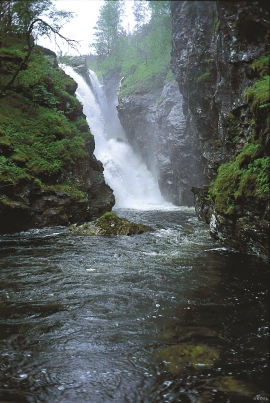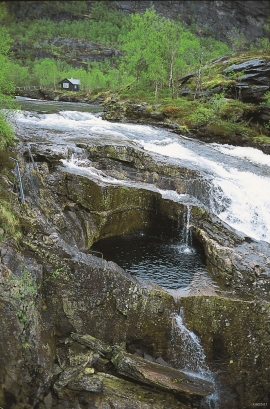Published: 31.07.2015 | Author: Inge Aarseth
The steep drop by Fossen cliff has been the biggest challenge for those who wished to make a road over Kvamskogen through the years. Leave the car by the monument on the old road and take a walk down to the bend by the waterfall that Bergen-folk call "The bridal veil". Why is there a waterfall just here?
During large periods of the ice ages, much of the glacier from Hardanger Fjord flowed over Kvamskogen to Samnanger. On its way further out toward the Norwegian Oceanic Trench, the ice went via Fusa Fjord and Kors Fjord. By Fossen cliff the ice merged together with the glacier from Tveitakvitingen down toward Raunebotnen. Together, they carved out a trough under the ice, such that there arose a step in the valley where the water now flows out from. It helped a lot that the gneiss had a lot of cracks just here; Raunebots valley is carved out along these north-south-trending cracks. In the fracture zones the glacier plucked loose large pieces of the bedrock. These pieces got frozen into the bottom of the glacier and helped to carve away the mountain further down through the valley.
In the mountainside north of the waterfall, one clearly sees an area with tightly packed vertical fractures in the bedrock that run north-south. Along the fractures there are also signs of landslides; one occurred in the winter of 1999.
From the top of the waterfall there is a view to two river fans in the valley below. The trough the glacier carved out is now filled with loose deposits. Here, it is nearly flat, and the river has too little energy to transport the coarsest flood deposits any further. When the big stones get deposited in the river channel during a flood, the nearest part of the river channel will get plugged up, and the river is forced to make a new path. In this way the river is constantly changing its flow direction. The result is a system of active and abandoned river channels that branch out and form river fans.
Along the river, 75 metres above the waterfall, there is a 7 metre-deep pot-hole in the gneiss. Here, there is rare to find big pot-holes in gneiss. If there is little water in the river, we can also study many smaller pot-holes in the coastal rocks just above the big pot-hole.
Transient "steps"
The many waterfalls along the valleys of western Norway are something we can thank the glaciers for. A glacier carves in fact very unevenly: deeply where the bedrock is fractured, less deep where the bedrock is massive. Downward through the valley, the terrain will therefore often alternate between waterfalls and streams, places with deep canyons, and flatter areas or lakes. The valley takes on a "stair-shaped" profile. The glaciers are for the most part gone, and it is the rivers or landslides that are responsible for the continued carving of the valleys. And they try to even out the stair-shaped profile and take away the waterfalls that the glaciers have made. In a geological perspective, this work has only just begun.
The waterfall's cliff is a good example of one of nature's big stairs. Just below the bridge across from Røssebotnen is another, albeit smaller scale (picture). Here, the river has found its way to two fracture zones in a "stair" that the glacier has formed in the landscape. The river is trying to remove the waterfall and even out the river channel by carving a narrow canyon in the fracture zone. The canyon by the side of the road is about 15 metres deep and just 2-3 metres wide. It is believed to have been started by a glacial-melt river toward the end of the Ice Age. Therefore, the river has been at work for "only" about 12 000 years, and it will take many thousands more before the waterfall is completely gone.






